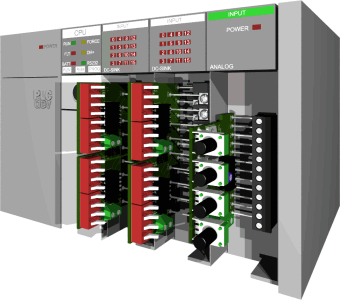PLC Programming HandbooksPopular ArticlesNavigationUser login |
 PLCdev is your home for quality simulators for Programmable Logic Controllers from Allen Bradley, GE Fanuc, Siemens, Modicon, Mitsubishi, Omron, Automation Direct and anything else you're using. We specialize in making PLC test boards to simulate your control environment so that you can debug your programs on your desk or in the field. And if that wasn't enough we offer educational materials, articles and tips for the novice to the advanced programmer. We invite you to register so that you can receive timely updates to PLCdev. Thanks for coming and visit again soon! Creating an Integrator Function Block in Modicon Conceptby C. Stanley This is the second article in a series that shows how to create user defined function blocks using Modicon Concept v2.6 programing software. This article will show how to create an integrator function block. Many basic control system component blocks contain an integrator function. Some examples are PID, Lead-Lag and filter blocks. An integrator function has an output that is the time integral of the input signal. ( categories: )
How to Configure 4-20 mA Analog Inputs on a PLCby Johan Esvelt from DIVIZE A PLC (Programmable Logic Controller) is used for the control of industrial machines and process installations. The PLC was designed specially for this purpose and offers the possibility of a flexible configuration by means of hardware and software to be adapted to the machine or process which needs to be controlled. Analog signals such as pressure and temperature from the process are evaluated by the PLC and based on these signals the process is controlled by the PLC. Analog signals need to be connected to the PLC and configured. Because of the modular design and configuration of the PLC many things can go wrong. This article gives some guidelines. ( categories: )
Creating a Defined Function Block in Modicon Conceptby C. Stanley This article will show how to create user defined function blocks. The first block, a summing junction, was chosen to be simple in nature to illustrate the steps in creation without unnecessary complication. Future articles will not be as in depth with creation mechanics and spend more effort on the functionality. The culmination of these series of articles will be a functional turbine speed control. The programming package for this series is Modicon Concept v2.6s. ( categories: )
Install and Test a MVI46-MCM Modbus Module for SLC-500by Nugroho Budi from controlmanuals.com The MVI46-MCM is a Modbus communication module provided by ProSoft Technology. The module can be installed in a SLC500 rack so it can communicate to other Modbus devices. ( categories: )
Siemens S7 Status WordIn Siemens PLCs the Status Word is an internal CPU register used to keep track of the state of the instructions as they are being processed. In order to use STL more effectively it is important to understand the Status Word and its functions. ( categories: )
Siemens S7 Indirect AddressingThe following is provided by Automation Training from their excellent Siemens Step 7 training manual. This is a really nice explanation of a difficult but important subject. Check out their website for hands-on and online training classes. ( categories: )
Learn Ladder Logic with a Free Version of RSLogix 500 and RSEmulator 500One of my most common questions is, “Where can I get a free download of RSLogix 500?â€Â For any serious development with SLC500 or MicroLogix there is no free option but there is a nice free option if you only want to learn and/or program a MicroLogix 1000 or 1100. Programming a MicroLogix is very very similar to programming a SLC500 or in that case a PLC5 too. Allen Bradley offers as a free download a software package called RSLogix Micro Starter Lite which is essentially the same programming environment as RSLogix 500. On top of that, they also offer RSLogix Emulate for free so that you don’t even need a PLC to run and test your ladder logic. Keep reading and I’ll show you how to get the software and set it up. ( categories: )
RSLogix 5000 Add-On Instructionsby John Schop One of the most powerful newer features of the RSLogix 5000 program is the ability to create Add-On Instructions. This allows a programmer to define an instruction that contains a commonly used function or algorithm (as a set of instructions), and use it as one instruction. To illustrate how this works, I am going to create an instruction that operates a cylinder, and because I’m making an add-on instruction, I can use that same instruction to control any number of cylinders in my application ( categories: )
Connecting Excel to ControlLogixby John Schop Have you ever lost data in a CLX processor, because you downloaded new code? Unfortunately, when you donwload a program to a ControlLogix processor, you also download the values of the tags (variables). A solution to this problem that could be useful, is an Excel sheet that reads and writes values to the ControlLogix processor using the DDE/OPC capabilities of RSLinx. In this article, I will show you how to create one of these sheets for your projects. Here's what you'll need: ( categories: )
Step 7 Connecting, Downloading and UploadingThese are general guidelines for connecting, downloading and uploading from an S7-300 or S7-400 PLC. The following procedures were created using Siemens SIMATIC STEP 7 version 5.4 software. ( categories: )
|

